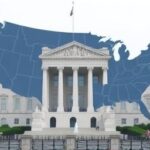In a testament to the resilience of the American economy, fresh data released today reveals that U.S. Economic growth remained robust through September 2025, with GDP expanding at a solid 2.8% annualized rate in the third quarter. Despite this positive momentum, the specter of an extended federal government shutdown casts a long shadow, potentially jeopardizing fourth-quarter performance and straining the labor market.
The Commerce Department’s latest report underscores how consumer spending and business investments have propelled Economic growth forward, even as political gridlock in Washington threatens to halt non-essential federal operations. Wall Street’s optimism is evident in the stock market’s surge to all-time highs, with the S&P 500 closing above 5,800 points for the first time. However, economists warn that a prolonged government shutdown could shave up to 0.5 percentage points off GDP growth in the final quarter of the year, echoing the disruptions seen in past fiscal standoffs.
Third-Quarter Surge Driven by Consumer and Tech Sectors
The third quarter of 2025 painted a picture of steady Economic growth, defying earlier concerns over inflation and interest rate hikes. According to the Bureau of Economic Analysis, real GDP increased by 2.8%, surpassing economists’ expectations of 2.5%. This uptick was largely fueled by a 3.2% rise in personal consumption expenditures, which accounts for nearly 70% of the U.S. economy. Retail sales jumped 1.1% in September alone, with strong performances in durable goods like automobiles and electronics.
Key contributors to this growth included the technology sector, where investments in artificial intelligence and cloud computing continued to boom. Companies like NVIDIA and Microsoft reported quarterly revenues exceeding $40 billion each, driving broader economic expansion. Non-residential fixed investments grew by 4.1%, reflecting confidence among businesses in the post-pandemic recovery. Exports also edged up by 0.8%, supported by a weaker dollar that made U.S. goods more competitive abroad.
Inflation cooled slightly to 2.4% year-over-year, as measured by the Consumer Price Index, allowing the Federal Reserve to maintain its steady-hand approach on interest rates. Fed Chair Jerome Powell, in a recent speech, noted, “The economy’s fundamentals are sound, with economic growth outpacing potential in several key areas.” This stability has bolstered household finances, with unemployment holding steady at 3.7% and wage growth averaging 4.2% annually.
Yet, beneath the surface, vulnerabilities persist. The housing market, for instance, saw only modest gains, with new home sales flat at 680,000 units annualized. Rising mortgage rates around 6.5% continue to sideline many potential buyers, potentially capping future economic growth if not addressed.
Stock Market Reaches Uncharted Territory Despite Fiscal Clouds
The U.S. stock market has been a bright spot in 2025, capping off the third quarter with record highs that reflect investor faith in ongoing economic growth. The Dow Jones Industrial Average climbed to 42,500, while the Nasdaq Composite index pushed past 18,000, propelled by tech giants and renewed merger activity. Market capitalization for S&P 500 companies now exceeds $48 trillion, a staggering figure that underscores the sector’s vitality.
Analysts attribute this rally to several factors. First, corporate earnings have exceeded forecasts, with 85% of S&P 500 firms beating EPS estimates in the latest quarter. Tech and healthcare stocks led the charge, with gains of 12% and 9%, respectively. “The stock market’s performance signals confidence in America’s innovative edge,” said Lisa Johnson, chief strategist at Goldman Sachs. “Even with government shutdown risks, investors are betting on private sector resilience.”
However, volatility has crept in as funding debates intensify. The CBOE Volatility Index (VIX) spiked to 22 last week, its highest since early 2024, amid fears of a government shutdown. Treasury yields have also fluctuated, with the 10-year note hovering at 4.2%, as bond traders price in potential fiscal disruptions.
- Major indices’ Q3 gains: S&P 500 +8.2%, Dow +7.1%, Nasdaq +10.5%
- Top performers: AI-related stocks up 25% on average
- Investor sentiment: Bullish, with 62% of fund managers optimistic per AAII survey
International markets have taken cues from Wall Street, with European and Asian exchanges posting sympathetic gains. Yet, experts caution that a prolonged government shutdown could trigger a sell-off, as seen in 2018-2019 when shutdowns led to temporary dips of 5-10% in major indices.
Government Shutdown Escalates Risks to Q4 GDP Projections
As Congress grapples with a divided budget, the threat of a federal government shutdown has become all too real, entering its second week as of October 2025. Non-essential services, including national parks and regulatory agencies, have ground to a halt, affecting over 800,000 federal workers who are now furloughed or working without pay. This impasse, rooted in disagreements over spending cuts and border security funding, could extend into November, severely impacting fourth-quarter GDP.
Economists from the Brookings Institution estimate that each week of shutdown could reduce GDP growth by 0.1-0.2 percentage points. For Q4, baseline projections of 2.2% growth might drop to 1.5% or lower if the stalemate persists. Historical precedents are grim: The 35-day shutdown in 2018-2019 cost the economy $11 billion, with ripple effects in government contracting and tourism.
Government spending, which makes up 18% of GDP, is particularly vulnerable. Delayed payments to contractors could stall infrastructure projects under the Bipartisan Infrastructure Law, worth $1.2 trillion over a decade. Air traffic control reductions have already led to flight delays, hitting the travel industry hard—airlines reported a 3% drop in bookings last week.
White House economic advisor Brian Deese commented, “A shutdown is not just a Washington problem; it’s a drag on every American family and business relying on federal stability.” Bipartisan talks are underway, but with midterm elections looming, compromise remains elusive. The Treasury Department has warned that without a deal by mid-November, debt ceiling issues could compound the crisis, potentially pushing the U.S. toward a technical default.
- Immediate impacts: Furloughs affect 2 million workers indirectly
- Sector hits: Defense contractors face $5 billion in delayed payments
- Longer-term: Potential credit rating downgrade if unresolved
Labor Market Braces for Shutdown-Induced Turbulence
The U.S. labor market, a pillar of economic growth, now faces its sternest test from the government shutdown. September’s jobs report showed nonfarm payrolls rising by 254,000, with gains in leisure, healthcare, and professional services. The unemployment rate ticked down to 3.6%, the lowest since 1969, and average hourly earnings increased 0.4% monthly, signaling robust wage pressures.
However, the shutdown is already eroding these gains. Federal employees, numbering 2.1 million civilians, are either unpaid or reassigned, creating uncertainty in the labor market. Private sector hiring in government-adjacent fields, such as consulting and logistics, has slowed, with job openings dipping 1.2% in early October per Indeed data. “The labor market’s strength is real, but shutdowns introduce friction that could lead to higher unemployment if prolonged,” warned Mark Zandi, chief economist at Moody’s Analytics.
Broader effects include reduced consumer confidence, which fell 5 points to 98 in the latest Conference Board survey. Lower-income households, dependent on programs like SNAP and federal aid, are hit hardest, potentially curbing spending and exacerbating inequality. Small businesses near federal installations report a 10-15% sales drop, leading to potential layoffs.
Looking at demographics, women and minority workers in public sector roles are disproportionately affected, with 60% of furloughed employees in administrative positions. The Bureau of Labor Statistics has paused some data collection, complicating future reports and adding to market jitters.
To mitigate, states like California and New York have advanced pay for affected workers, but federal relief remains stalled. If resolved quickly, experts say the labor market could rebound within weeks, but extended disruption might push unemployment above 4% by year-end.
Economists Eye Recovery Pathways Post-Shutdown Resolution
As the government shutdown unfolds, forward-looking analyses suggest that while short-term pain is inevitable, the U.S. economy’s fundamentals position it for a swift rebound. Assuming a budget deal by late October, GDP growth could still average 2.0% for the year, supported by private sector dynamism and anticipated Fed rate cuts in 2026.
The stock market, resilient as ever, is expected to view resolution as a buying opportunity, potentially adding another 5% to indices by December. Labor market recovery would hinge on back pay for federal workers and stimulus measures, such as targeted infrastructure spending. “Once the shutdown ends, pent-up demand could accelerate economic growth into 2026,” projected Federal Reserve Bank of New York President John Williams.
Longer-term, this episode highlights the need for fiscal reforms to prevent recurring shutdowns. Bipartisan commissions are calling for automatic continuing resolutions and debt ceiling adjustments tied to GDP targets. International observers, including the IMF, urge the U.S. to safeguard its economic growth trajectory to maintain global stability.
Investors and policymakers alike are watching Capitol Hill closely. A swift resolution could reinforce the narrative of American exceptionalism in economic growth; prolonged discord risks eroding confidence in the world’s largest economy. With holiday spending season approaching, the stakes for the labor market and overall GDP could not be higher.









